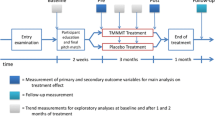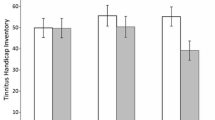Abstract
Objectives
Tinnitus consists of a more or less constant aversive tone or noise and is associated with excess auditory activation. Transient distortion of this activation (repetitive transcranial magnetic stimulation, rTMS) may improve tinnitus. Recently proposed operant training in real-time functional magnetic resonance imaging (rtfMRI) neurofeedback allows voluntary modification of specific circumscribed neuronal activations. Combining these observations, we investigated whether patients suffering from tinnitus can (1) learn to voluntarily reduce activation of the auditory system by rtfMRI neurofeedback and whether (2) successful learning improves tinnitus symptoms.
Methods
Six participants with chronic tinnitus were included. First, location of the individual auditory cortex was determined in a standard fMRI auditory block-design localizer. Then, participants were trained to voluntarily reduce the auditory activation (rtfMRI) with visual biofeedback of the current auditory activation.
Results
Auditory activation significantly decreased after rtfMRI neurofeedback. This reduced the subjective tinnitus in two of six participants.
Conclusion
These preliminary results suggest that tinnitus patients learn to voluntarily reduce spatially specific auditory activations by rtfMRI neurofeedback and that this may reduce tinnitus symptoms. Optimized training protocols (frequency, duration, etc.) may further improve the results.


Similar content being viewed by others
Abbreviations
- BOLD:
-
blood oxygenation level dependent
- DLPFC:
-
dorso-lateral prefrontal cortex
- EEG:
-
electroencephalography
- EPI:
-
echoplanar imaging
- fMRI:
-
functional magnetic resonance imaging
- rtfMRI:
-
real-time functional magnetic resonance imaging
- rTMS:
-
repetitive transcranial magnetic stimulation
- VLPFC:
-
ventro-lateral prefrontal cortex
References
Heller AJ (2003) Classification and epidemiology of tinnitus. Otolaryngol Clin North Am 2:239–248
Dobie RA (2003) Depression and tinnitus. Otolaryngol Clin North Am 2:383–388
Dobie RA (1999) A review of randomized clinical trials in tinnitus. Laryngoscope 8:1202–1211
Muhlnickel W, Elbert T, Taub E et al (1998) Reorganization of auditory cortex in tinnitus. Proc Natl Acad Sci U S A 17:10340–10343
Andersson G, Lyttkens L, Hirvela C et al (2000) Regional cerebral blood flow during tinnitus: a PET case study with lidocaine and auditory stimulation. Acta Otolaryngol 8:967–972
Kleinjung T, Eichhammer P, Langguth B et al (2005) Long-term effects of repetitive transcranial magnetic stimulation (rTMS) in patients with chronic tinnitus. Otolaryngol Head Neck Surg 4:566–569
Rossi S, De Capua A, Ulivelli M et al (2007) Effects of repetitive transcranial magnetic stimulation on chronic tinnitus. A randomised, cross over, double blind, placebo-controlled study. J Neurol, Neurosurg Psychiatry
Plewnia C, Reimold M, Najib A et al (2007) Dose-dependent attenuation of auditory phantom perception (tinnitus) by PET-guided repetitive transcranial magnetic stimulation. Hum Brain Mapp 3:238–246
Miller NE (1975) Clinical applications of biofeedback: Voluntary control of heart rate, rhythm, and blood pressure. In: Russel HI (ed) New horizons in cardiovascular practice. University Park Press, Baltimore, pp 239–249
Kubler A, Kotchoubey B, Hinterberger T et al (1999) The thought translation device: a neurophysiological approach to communication in total motor paralysis. Exp Brain Res 2:223–232
Birbaumer N, Ghanayim N, Hinterberger T et al (1999) A spelling device for the paralysed. Nature 6725:297–298
Weiskopf N, Veit R, Erb M et al (2003) Physiological self-regulation of regional brain activity using real-time functional magnetic resonance imaging (fMRI): methodology and exemplary data. Neuroimage 3:577–586
Weiskopf N, Scharnowski F, Veit R et al (2004) Self-regulation of local brain activity using real-time functional magnetic resonance imaging (fMRI). J Physiol Paris 4–6:357–373
Weiskopf N, Sitaram R, Josephs O et al (2007) Real-time functional magnetic resonance imaging: methods and applications. Magn Reson Imaging 6:989–1003
deCharms RC, Maeda F, Glover GH et al (2005) Control over brain activation and pain learned by using real-time functional MRI. Proc Natl Acad Sci U S A 51:18626–18631
deCharms RC (2007) Reading and controlling human brain activation using real-time functional magnetic resonance imaging. Trends Cogn Sci 11:473–481
Zenner HP, De Maddalena H (2005) Validity and reliability study of three tinnitus self-assessment scales: loudness, annoyance and change. Acta oto-laryngologica 11:1184–1188
Goebel G, Hiller W (1994) [The tinnitus questionnaire. A standard instrument for grading the degree of tinnitus. Results of a multicenter study with the tinnitus questionnaire]. HNO 3:166–172
Seifritz E, Esposito F, Hennel F et al (2002) Spatiotemporal pattern of neural processing in the human auditory cortex. Science 5587:1706–1708
Caria A, Veit R, Sitaram R et al (2007) Regulation of anterior insular cortex activity using real-time fMRI. Neuroimage 3:1238–1246
Biswal B, Yetkin FZ, Haughton VM et al (1995) Functional connectivity in the motor cortex of resting human brain using echo-planar MRI. Magn Reson Med 4:537–541
Damoiseaux JS, Rombouts SA, Barkhof F et al (2006) Consistent resting-state networks across healthy subjects. Proc Natl Acad Sci U S A 37:13848–13853
Raichle ME, MacLeod AM, Snyder AZ et al (2001) A default mode of brain function. Proc Natl Acad Sci U S A 2:676–682
Ochsner KN, Ray RD, Cooper JC et al (2004) For better or for worse: neural systems supporting the cognitive down- and up-regulation of negative emotion. Neuroimage 2:483–499
Eippert F, Veit R, Weiskopf N et al (2007) Regulation of emotional responses elicited by threat-related stimuli. Hum Brain Mapp 5:409–423
Critchley HD, Wiens S, Rotshtein P et al (2004) Neural systems supporting interoceptive awareness. Nat Neurosci 2:189–195
Critchley HD, Melmed RN, Featherstone E et al (2002) Volitional control of autonomic arousal: a functional magnetic resonance study. Neuroimage 4:909–919
Sitaram R, Caria A, Veit R et al (2007) FMRI brain-computer interface: a tool for neuroscientific research and treatment. Comput Intell Neurosci 25487
Gosepath K, Nafe B, Ziegler E et al (2001) [Neurofeedback in therapy of tinnitus]. HNO 1:29–35
Dohrmann K, Weisz N, Schlee W et al (2007) Neurofeedback for treating tinnitus. Prog Brain Res 473–485
Nelson LA (2007) The role of biofeedback in stroke rehabilitation: past and future directions. Top Stroke Rehabil 4:59–66
Bilecen D, Scheffler K, Schmid N et al (1998) Tonotopic organization of the human auditory cortex as detected by BOLD-FMRI. Hear Res 1–2:19–27
Cohen ER, Ugurbil K, Kim SG (2002) Effect of basal conditions on the magnitude and dynamics of the blood oxygenation level-dependent fMRI response. J Cereb Blood Flow Metab 9:1042–1053
Acknowledgements
We thank all subjects for participation in the study.
Conflict of interest
No conflicts of interest.
Author information
Authors and Affiliations
Corresponding author
Rights and permissions
About this article
Cite this article
Haller, S., Birbaumer, N. & Veit, R. Real-time fMRI feedback training may improve chronic tinnitus. Eur Radiol 20, 696–703 (2010). https://doi.org/10.1007/s00330-009-1595-z
Received:
Revised:
Accepted:
Published:
Issue Date:
DOI: https://doi.org/10.1007/s00330-009-1595-z




